The Best Powered Bed Movers For Hospitals (Updated for 2024)
If you’re reading this article, you’re likely looking at ways in which you can reduce the risk of musculoskeletal injuries to porters and nursing staff from moving beds and stretchers around your hospital.
Many trusts are implementing powered bed movers in their hospitals, which reduce the risk of injury and improve efficiency when moving beds and stretchers around hospitals, by taking the weight and load off the person pushing the equipment.
Traditional bed movers are often seen as large, bulky pieces of equipment, which are difficult to use and manoeuvre around hospital corridors, and whilst this is the case for certain types of bed movers, in this article we will be comparing 4 of the best powered bed movers on the market in 2023, so you are able to choose the most appropriate for your hospital.
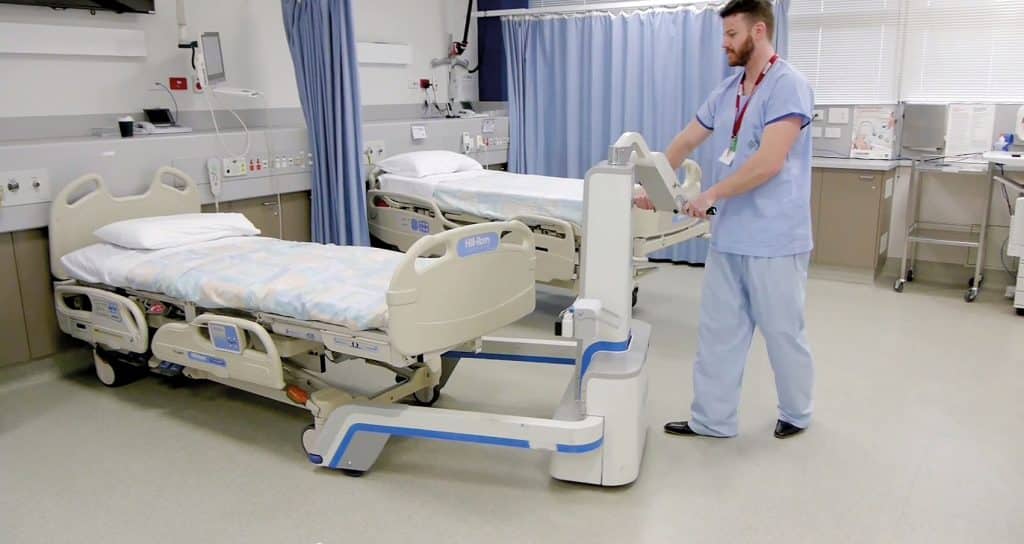
The best powered bed movers for hospitals
StaminaLift TS5000 Bed Mover
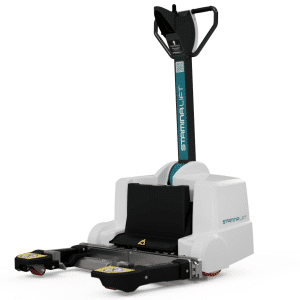
The StaminaLift TS5000 is a bed mover that attaches to a large number of beds and stretchers via a jaw system that grips onto the castor wheels of the bed or stretcher.
Positives
- Compatible with a large range of beds and stretchers. The StaminaLift TS5000 attaches to the bed’s castor wheels, which are largely universal and subsequently the TS5000 can be fitted to most beds and stretchers. To the best of our knowledge, there are only 2 beds that the Stamina doesn’t work with – and the use of an adaptor means that there is a good solution for these too.
- 360-degree turning radius, for easy manoeuvring through even the most challenging hospital corridors and doorways.
- Simplicity of use. It just does what it says on the tin!
Drawbacks
- Bulky. The StaminaLift is one of the bulkier bed movers on the market, adding some length to the bed when attached. This will potentially present problems if your hospital has lifts – often hospital beds are a very tight fight in a lift (particularly with air pumps or suction on end of bed) and the Stamina may not fit in without being detached first.
- Joystick control – it can take users sometime to get used the joystick control.
PTS P4 Multi Bed Mover
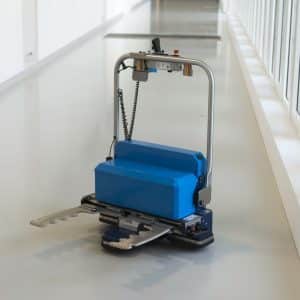
The PTS P4 Bed Mover attaches to beds and mattresses just above the castor wheels using a modular claw system and is controlled using a joystick.
Positives
- Compact design. The bulk of the PTS P4 bed mover goes underneath the bed, meaning the additional length it adds is minimal. Once you have finished using the PTS P4, the claws fold up for compact storage.
- Compatible with a large range of beds and stretchers. The PTS P4’s claw system is modular/made to measure and subsequently can be fitted to a large number of beds and stretchers.
Drawbacks
- Joystick isn’t intuitive. Users of the PTS P4 bed mover report that the joystick is difficult to use, and not intuitive. This can result in the Portering team deciding not to use the equipment because they see it as a hassle and difficult to use.
- Requires modifying to suit different beds and stretchers. The downside to the bed mover being modular is that the porters may have to change the claw attachment multiple times throughout the day to be able to use it for each of your beds and stretchers.
- Joystick position. The Joystick clips onto the opposite end of the bed to where the bedmover sits. In some scenarios, this may mean that the patient cannot face the direction of travel.
Felgains GZ10SL Slimline Bed Mover
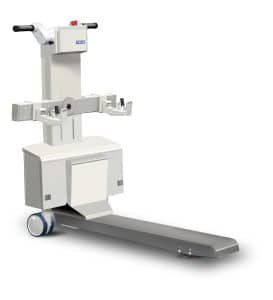
The Felgains GZ10SL Bed Mover is powerful enough to transport up to 500kg around the hospital, keeping portering and nursing staff safe from musculoskeletal injuries.
The single tine slides under the bed or stretcher – requiring only 90mm of clearance – creating effectively a 5th wheel powered drive. This, combined with the compact design, enables easy manoeuvrability through tight corridors and in and out of lifts.
Positives
- Very compact design. The GZ10SL adds no additional width to the bed or stretcher, and adds less than 200mm (8 inches) to the length, meaning it is very compact and can fit into the majority of hospital lifts.
- Easy and intuitive to manoeuvre. The GZ10SL is powered by a wheel at the end of the tine which slides underneath the bed, effectively creating a 5th wheel, making steering and manoeuvering a bed or stretcher much easier when compared to bed movers that are powered at the end of the bed, or via a joystick. This reduces the risk of the Portering team not using the product through it being difficult to use.
- Simple to attach to beds and stretchers. The GZ10SL attaches to the main frame of a bed or stretcher using a toolless ratchet system, which allows porters to attach it to beds and stretchers more quickly compared to bed movers that attach to caster wheels or under the main structure.
Drawbacks
- Not compatible with all beds and stretchers. The GZ10SL requires 90mm of clearance underneath the bed or stretcher, which means it isn’t compatible with anything lower than this, or with beds or stretchers that have column lifts protruding below the main structure.
Felgains GZS Bed Mover
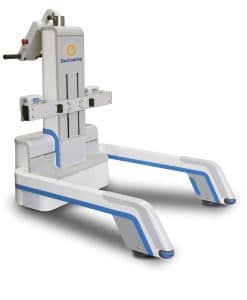
The Felgains GZS Bed Mover is powerful enough to transport up to 600kg around the hospital, keeping portering and nursing staff safe from musculoskeletal injuries.
The GZS fits around your beds and stretchers, rather than underneath them, so no under-bed clearance is required. This enables the GZS to work with a wide range of hospital beds and stretchers.
Positives
- Very wide compatibility. Because the GZS requires no under-bed clearance and doesn’t rely on attachment to castor wheels, the GZS is compatible with the vast majority of hospital beds and stretchers, reducing the need for buying multiple pieces of equipment to suit the different beds in your trust. It also means the Portering team have a single go-to bed mover, rather than having to decide which bed mover to use for each bed or trolley.
- Compact design. The two arms of the GZS go underneath the main mattress platform, meaning no additional width is added to a standard hospital bed.
- Easy and intuitive to manoeuvre. The GZS is powered by wheels at the end of the two tines, making steering and manoeuvering a bed or stretcher much easier when compared to bed movers that are powered at the end of the bed, or via a joystick. This reduces the risk of the Portering team not using the product because it is difficult to use.
- Simple to attach to beds and stretchers. The GZS attaches to the main frame of a bed or stretcher using a toolless ratchet system, which allows porters to attach it to beds and stretchers more quickly compared to bed movers that attach to caster wheels or under the main structure.
Drawbacks
- Bulkier than the GZ10SL. The GZS adds more overall length to the bed when compared to the GZ10SL, which may mean it doesn’t fit into all hospital lifts. Also, unlike the PTS P4 Multi Bed Mover, the arms of the GZS don’t fold for compact storage.
- Method of attachment. Whilst the simple strap mechanism will fit most beds, it doesn’t secure as tightly – and thus the bed can yaw somewhat in its mounting.
Which bed mover should you choose?
Which bed mover you choose for your trust and hospitals will depend on your requirements and the hospitals you operate in, however, I trust this article has given you a good overview of each of the bed movers in the market, and the positives and drawbacks of each.
Most hospitals would look to arrange a demonstration or trial of a bed mover before going ahead with a purchase, and this is something we are happy to arrange for you. Feel free to contact us on 01473 741144, or via the contact form below, to get the conversation started.
Related articles
4 Tips To Avoid Porter Injury When Moving Hospital Beds And Stretchers
The Best Falls Lifting Equipment For Hospitals In 2023
Get in touch
Got a question or want to send us a message? Let’s talk.
